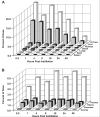Placental transport of brevetoxin-3 in CD-1 mice
- PMID: 17011606
- PMCID: PMC2561222
- DOI: 10.1016/j.toxicon.2006.08.008
Placental transport of brevetoxin-3 in CD-1 mice
Abstract
The purpose of this study was to examine the distribution of brevetoxin-3 administered to pregnant dams and to determine the extent of placental transport to fetuses. Twenty-nine pregnant CD-1 mice were administered (3)H-brevetoxin-3 ( approximately 1.3 microCi/animal; approximately 2.8 microg compound/kg) by intratracheal instillation on one of gestational days 15-18. Groups of four or five dams were killed at selected times through 48 h post-dosing. Four pregnant dams were administered (3)H-brevetoxin-3 on gestational day 15 or 16 via osmotic minipump to provide continuous delivery of compound ( approximately 0.13 microCi, 7.5 ng compound/day) over a 72-h period. Then the dams and fetuses were killed. Brevetoxin-associated radioactivity was detected in placentas and fetuses within 0.5h of intratracheal administration. Concentrations of brevetoxin equivalents in fetuses were approximately 0.3 ng/g throughout the 48-h post-dosing, resulting in a calculated dose to fetuses of 19 ng/gh. Following brevetoxin infusion, concentration of brevetoxin equivalents in fetuses was 0.1 ng/g, lower than that present in most maternal tissues. Results demonstrated placental transport of brevetoxin or its metabolites following maternal acute exposure and repeated low-dose exposure. The consequences of these findings for pregnant women exposed to brevetoxins by inhalation or ingestion remain to be determined.
Figures


References
-
- Backer LC, Fleming LE, Rowan A, Cheng YS, Benson J, Pierce RH, Zaias J, Bean J, Bossart GD, Johnson D, Quimbo R, Baden DG. Recreational exposure to aerosolized brevetoxins during Florida red tide events. Harmful Algae. 2003;2:19–28.
-
- Backer LC, Kirkpatrick B, Fleming LE, Cheng YS, Pierce R, Bean JA, Clark R, Johnson D, Wanner A, Tamer R, Zhou Y, Baden D. Occupational exposure to aerosolized brevetoxins during Florida red tide events: Effects on a healthy worker population. Environ Health Perspect. 2005;113(5):644–649. - PMC - PubMed
-
- Baden DG, Mende JJ, Bikhazi G, Leung I. Bronchoconstriction caused by Florida red tide toxins. Toxicon. 1982;20:929–932. - PubMed
Publication types
MeSH terms
Substances
Grants and funding
LinkOut - more resources
Full Text Sources

